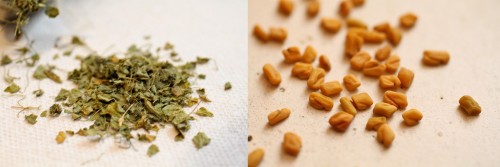Fenugreek
Fenugreek is like a gift and a curse to me. I love both the seeds and the leaves, but it’s one of those spices that stick. Crushing the leaves between you fingers will leave behind the sweet, celery-like smell, and I always have to douse my hands with lemon juice to get rid of it. And even then…That said, both add such incredible depth of character to dishes, they are staples in my spice pantry.
Fenugreek seeds are small, hard, and rectangular and have a bitter, vegetal flavor. They also have maple syrup-like notes, particularly when toasted. I know – sounds odd, but it’s true. The seeds are generally known to be used in Indian cooking and are a key spice in any given curry; I used them in my South Indian gazpacho. However, they are also used throughout Middle Eastern, North African, and even East African cooking – like in my version of Ethiopian clarified butter. It’s a fantastic spice if used in moderation (ground to a powder), and I actually love it paired with vegetables. It can add amazing flavor to a soup (I’m partial to asparagus), is delicious mixed in with an aioli for a condiment, and great in a dry rub.
The leaves can be either fresh or dried and are a subtler version of the seeds. I’ve actually never used fresh, so I can’t speak to it, but the dried form is incredible. I tend to use the leaves more frequently because they can fold in with other ingredients without overpowering a dish. They have a warm, sweet, grassiness to them, and the uses are never-ending. I love the leaves mixed in with yogurt as a dip for crudités, with any potato or vegetable purée (see my cauliflower one), in salads or dressings, in a dry rub for fish or chicken, to flavor a butter sauce…
I actually pick up my seeds at Dean & Deluca in Manhattan, but very few regular grocers carry it. And the leaves are a bit harder to find. Make sure to store the leaves out of the light – light will lighten the color and leach the flavor from them.






